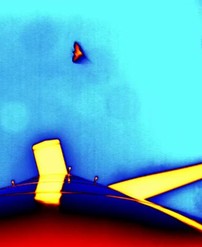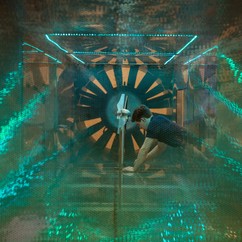Wind Energy News
NREL Seeks Feedback on Equity and Wind Energy
To better understand the current state of social equity as it relates to wind energy development, NREL is conducting the Wind Energy Equity Engagement Series. NREL researchers will collect stakeholder input through a variety of channels, including written feedback, interviews with wind energy subject matter experts, and community forums. The project team aims to collect stakeholder-identified priorities and challenges, community-based examples and use cases, plus ideas for further efforts and research.
In addition, the team aims to connect stakeholders interested in an equitable transition to wind and other forms of renewable energy. The team encourages wind energy consumers, members of the wind energy industry, and community leaders to share their input. If you would like to participate in this project, please contact Chloe.Constant@nrel.gov.

NREL Shines Light (Literally) on Bat Behavior
With support from WETO, researchers at the National Renewable Energy Laboratory (NREL) are working hard to create solutions that protect bats and other wildlife while ensuring sustainable deployment of wind energy.
"After nearly two decades of research, we have developed strategies for measuring wind energy impacts, observing bat behavior around wind turbines, and minimizing collision events," said Cris Hein, program coordinator for the Bats and Wind Energy Cooperative and senior project leader for NREL's wind energy environmental science portfolio.
A special issue of the journal Animals explores several of these strategies. Co-edited by Hein, the special issue focuses on advancements in methods used to assess bat populations, tools for studying bat activity and behavior (like thermal imaging cameras), and insights into which stimuli attract bats to wind turbines and which might deter them.
Read more about research on bats and wind energy and learn a few facts about bats.
NREL Model Can Predict Golden Eagle Behavior Around Wind Turbines
|
 Golden eagles will often find updrafts to assist their flight, letting them soar to greater heights without working too hard. However, those upward-moving gusts of wind are also gold for wind turbines.
The Stochastic Soaring Raptor Simulator, developed at NREL with support from WETO, can predict the likely long-distance flight paths of individual golden eagles (and other raptors) as they ride updrafts through the air. The model, which is publicly accessible on GitHub, will use a site's particular details to simulate long-distance movement of golden eagles, including migration.
"A golden eagle's goal to minimize its energy expenditure will affect its decision making. The model uses that principle to generate a map of probable paths the eagle might take," said Rimple Sandhu, a postdoctoral researcher at NREL and the lead author on the article published in Ecological Modelling.
Read more about the Stochastic Soaring Raptor Simulator and eagles and wind energy.
Unlocking Distributed Wind Energy’s Potential
A comprehensive analysis released by NREL indicates that nearly 1,400 gigawatts of distributed wind capacity could be profitably deployed today across the United States. This amounts to more than half of the nation’s current annual electricity consumption and is a big increase from the 1.1 gigawatts installed today.
“This study shows that distributed wind energy could bring clean power to millions of American households,” said Eric Lantz, NREL principal investigator of the study. “Distributed wind energy offers significant potential to help communities transition to a clean energy future and can deliver power to residential and industrial users near where it’s generated, without a need for transmission system expansion.”
The Distributed Wind Energy Futures Study highlights the technical and economic potential for distributed wind energy deployment at all scales—from kilowatts to megawatts—and considers opportunities for distributed wind energy in agricultural, commercial, industrial, and residential settings and in disadvantaged communities.
Companies Reach Innovative New Heights in Expanding Wind Technology
Unique problems call for unique solutions, which is exactly why companies from the wind technology industry are developing taller wind turbine towers at lower prices.
While Keystone Tower Systems is using spiral-welding in order to use less costly steel, and GE Renewables is experimenting with 3D printing to create customizable tower bases, they are both addressing the transportation barriers hindering taller wind turbines with support from WETO. Learn more about both in the DOE guest blog for the American Clean Power Association.
DOE Announces Teams to Participate in Phase 1 of the 2023 Collegiate Wind Competition

The U.S. Department of Energy (DOE) has announced the colleges and universities selected to participate in Phase 1 of the 2023 Collegiate Wind Competition (CWC). During the first half of the 2022-2023 school year, these teams will develop preliminary designs for a prototype turbine and a hypothetical wind farm site and conduct outreach with the wind energy industry.
By early 2023, the competition organizers will narrow the Phase 1 cohort to 12 teams, who will be invited to participate in the CWC in the second half of the school year. These teams will also be invited to present their work at the American Clean Power Association’s CLEANPOWER Conference & Exhibition in May 2023.
DOE announced the winners of the 2022 Collegiate Wind Competition in May. Kansas State University rose above 11 other competing teams to claim first place in the annual event.
NREL Analyzes Layouts for the First Floating Offshore Wind Energy Lease Areas on the West Coast
Building on previous assessments of wind resources and development costs off the California coast, researchers at NREL have released a report that proposes optimal arrangements for developing two wind energy leasing areas off the West Coast (Morro Bay and Humboldt) for the first time. The information required novel analyses of floating wind turbines for the Pacific Ocean’s deep waters and will help the U.S. Department of the Interior’s Bureau of Ocean Energy Management establish the first commercial offshore wind energy leases on the West Coast. Development could produce 4.5 gigawatts or more of power for over 1.5 million homes on the U.S. grid, according to the report. This would bring California closer to its 2045 goal of 100% clean retail electricity and the United States closer to its 2030 offshore wind energy and 2035 clean energy goals.
|
Events
WINDExchange Offshore Wind Energy Webinar: Technology Below the Water
Webinar: Jul 13, 2022
Offshore wind energy has the potential to deliver large amounts of clean, renewable power to fulfill the electrical needs of cities along U.S. coastlines.
Build your knowledge of this growing industry by joining WINDExchange for a webinar on offshore wind energy technology below the surface of the water. We’ll cover both fixed-bottom and floating turbines, cabling options and installation, and processes for decommissioning old turbines. We’ll also discuss technology options and development considerations for diverse seafloor characteristics.
Find more information on the webinar registration page.
NAWEA/WindTech 2022
Conference: Sept. 20–22, 2022, Newark, Delaware
The 2022 conference will reunite the North American Wind Energy Academy (NAWEA) Symposium and the International Conference on Future Technologies in Wind Energy (WindTech) while exploring two additional themes: grid integration and the social science of wind energy development.
NAWEA/WindTech 2022 will include six tracks: Grid integration, Social/Environmental Aspects of Wind Energy, Offshore Wind, Wind Turbine and Wind Plants, Atmospheric/Ocean Science for Wind Energy, and Applications and Education in Wind Energy.
Find more information on the WINDExchange event page.
Sandia Blade Workshop
Workshop: Oct. 17–20, 2022, Albuquerque, New Mexico
This workshop brings together wind industry experts, wind farm stakeholders and operators, manufacturers, and researchers to address the major topics for wind turbine blades, facilitate interaction and networking among the attendees, and identify future technology pathways. For more information, visit Sandia’s website.
Please visit the WINDExchange calendar to learn more about upcoming events.
|